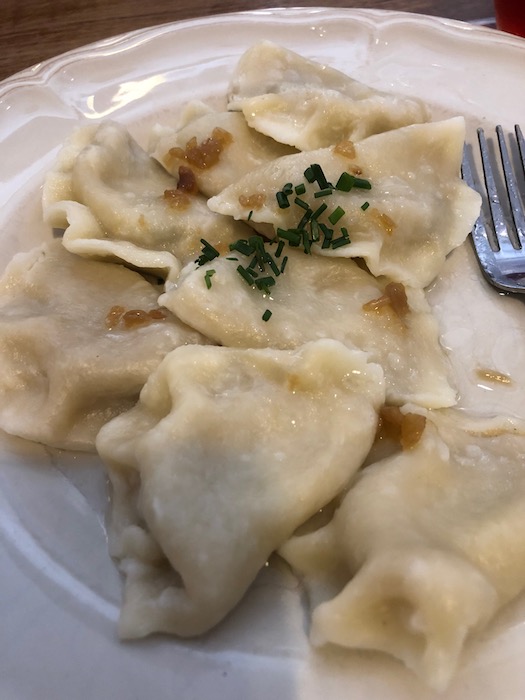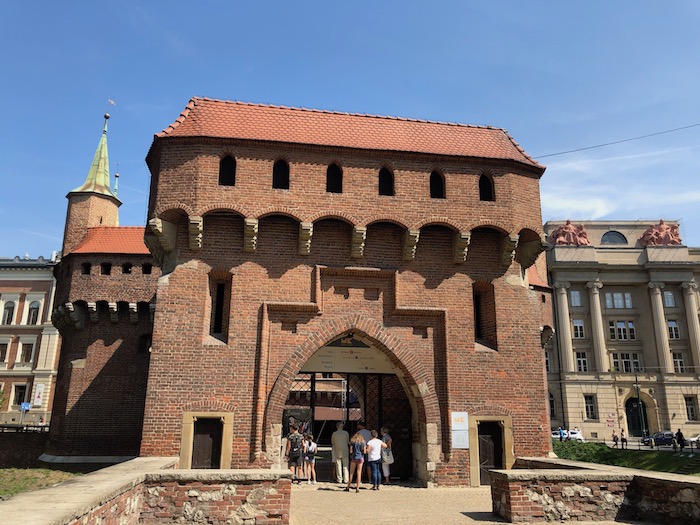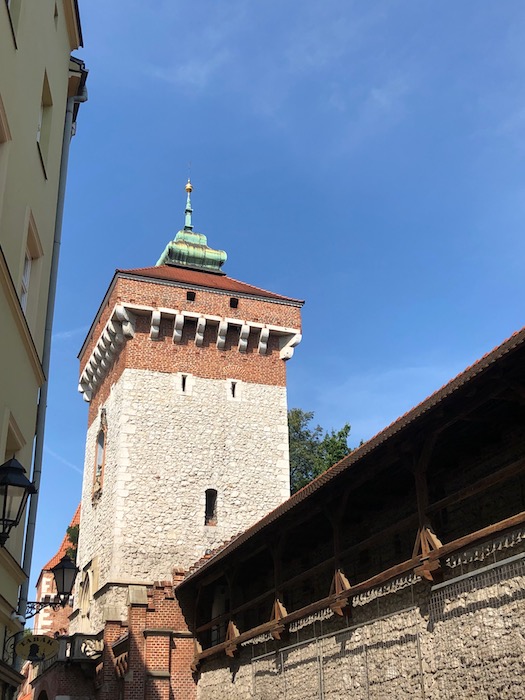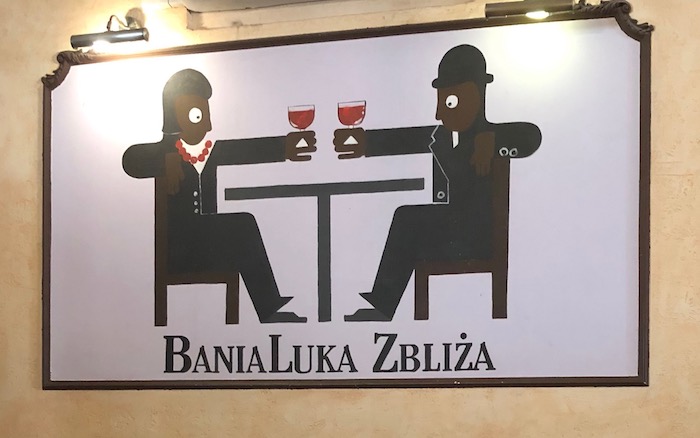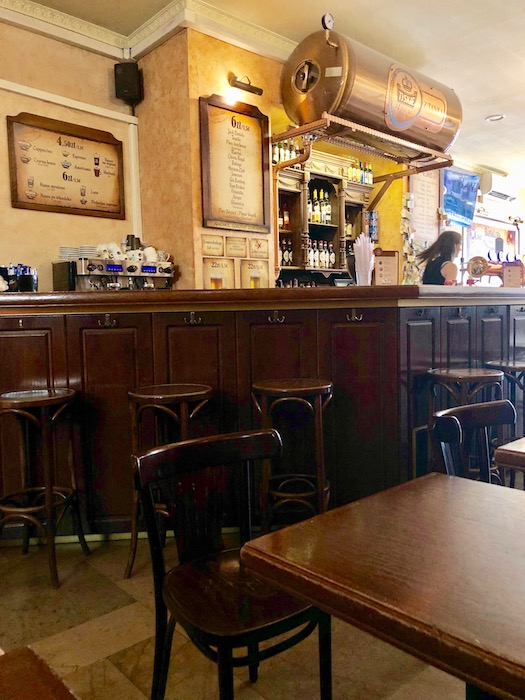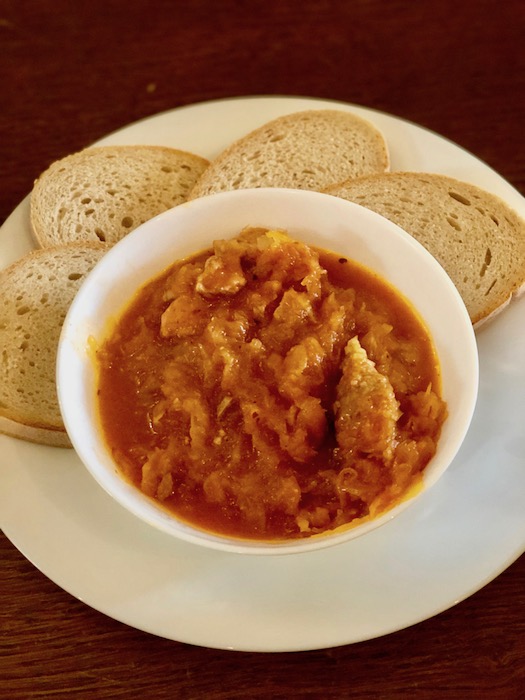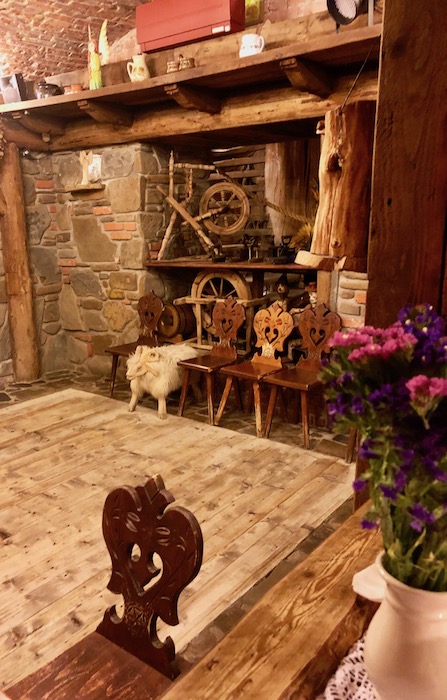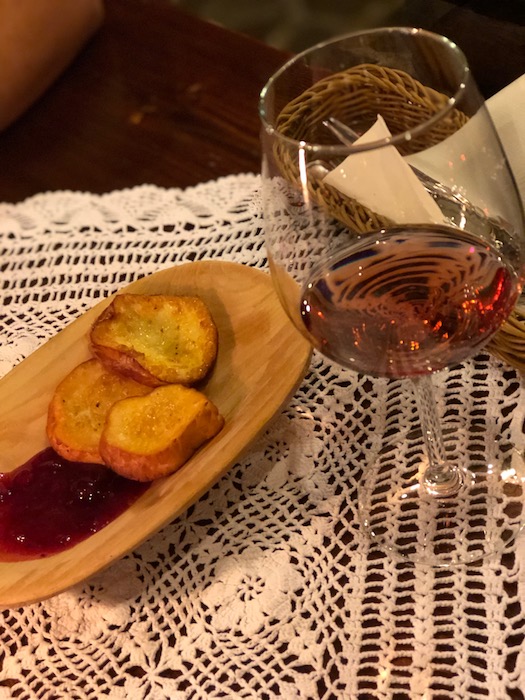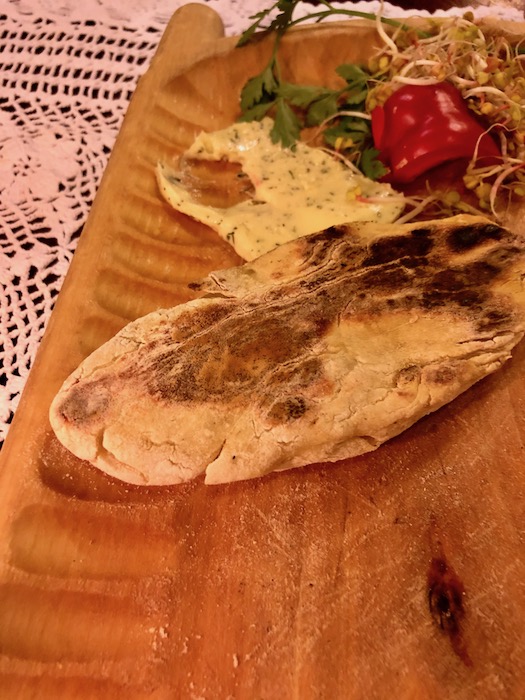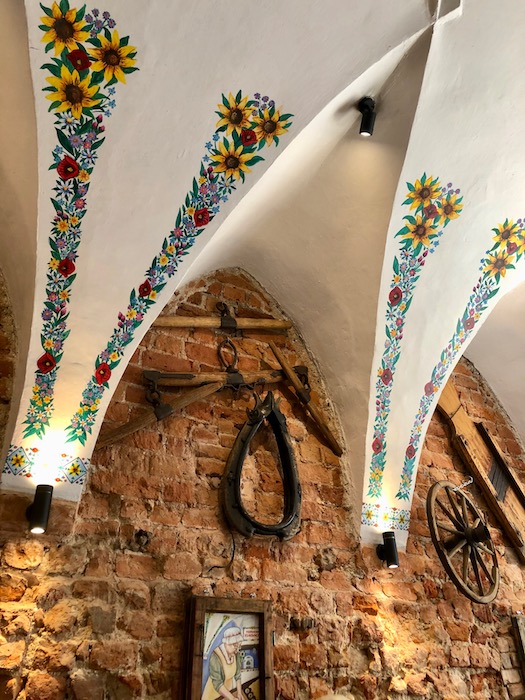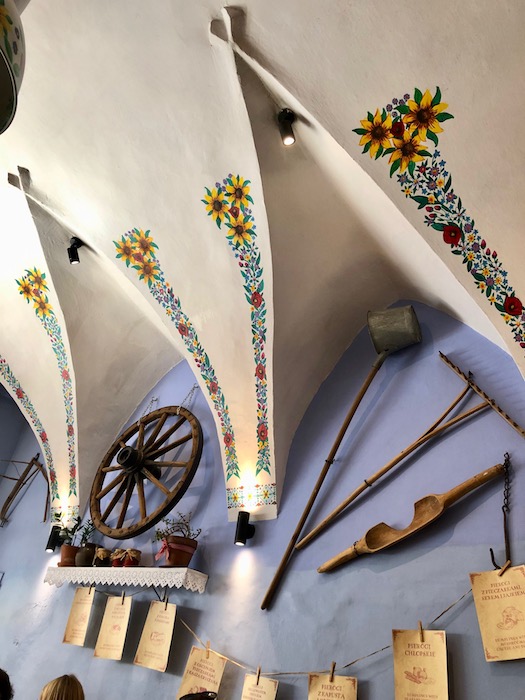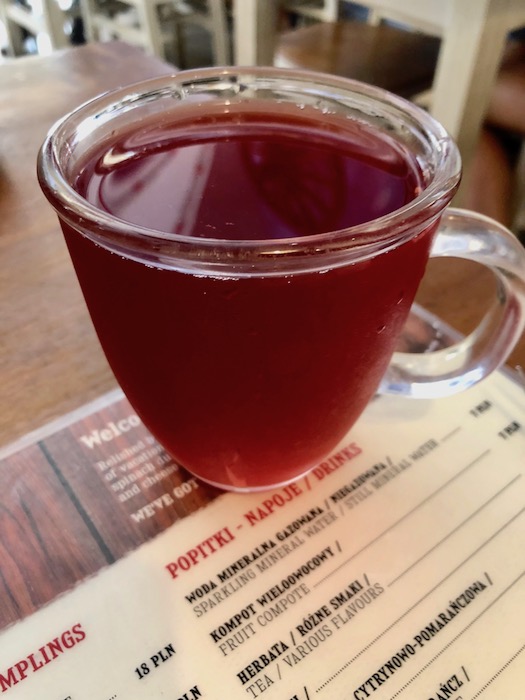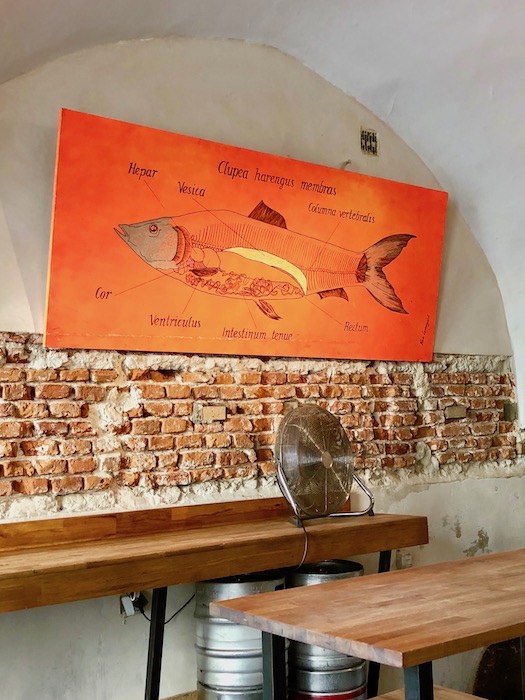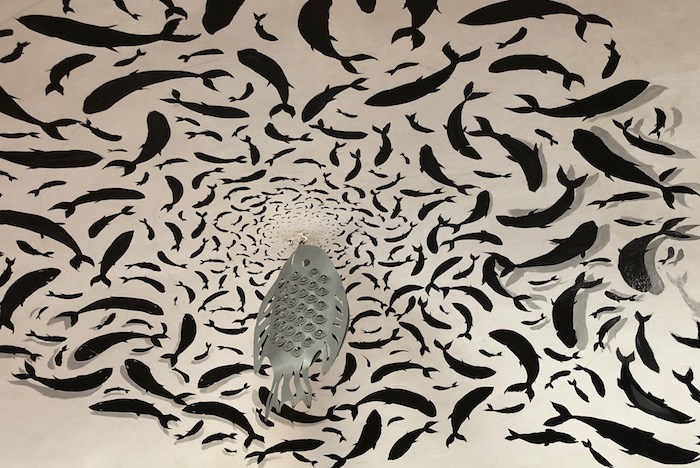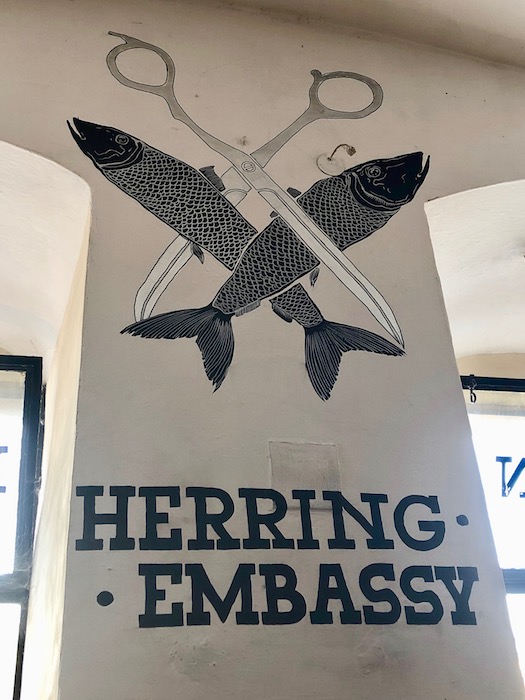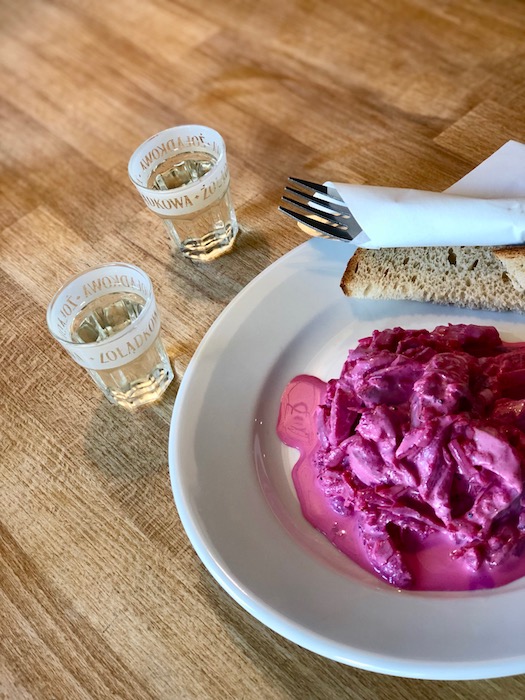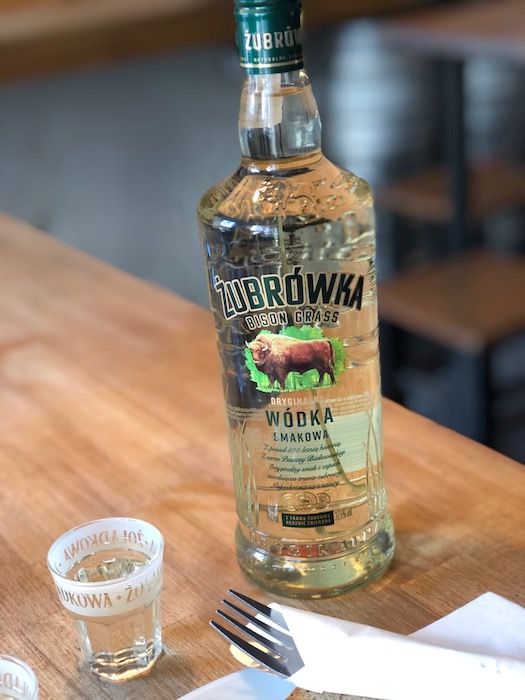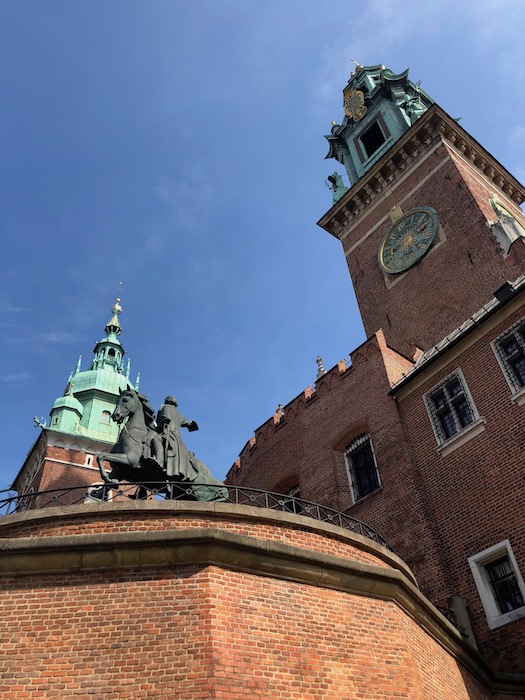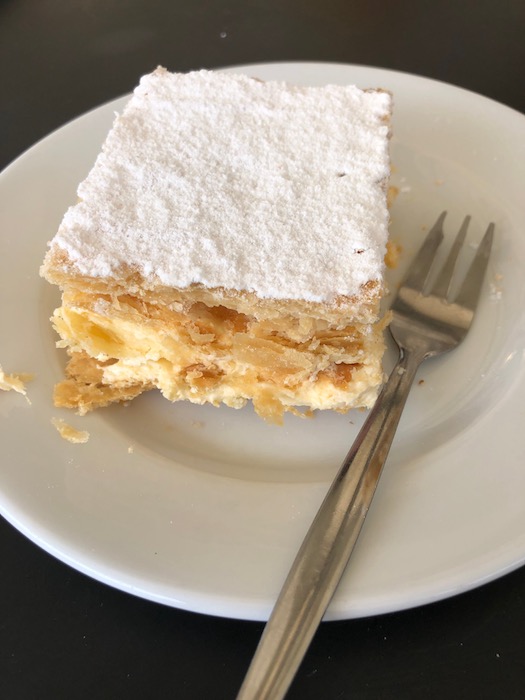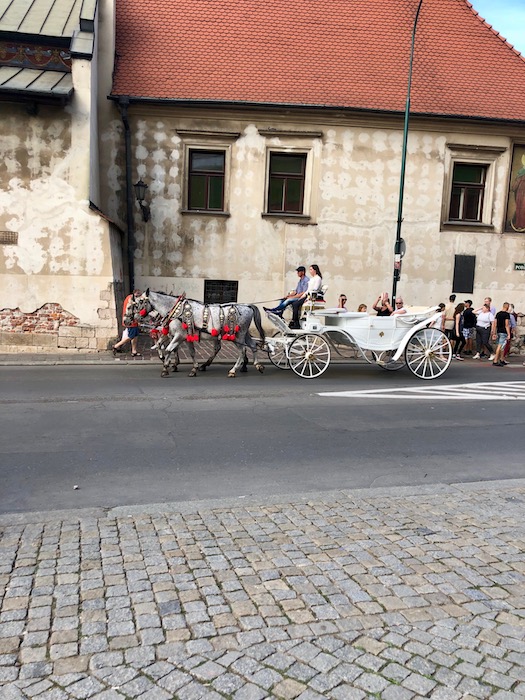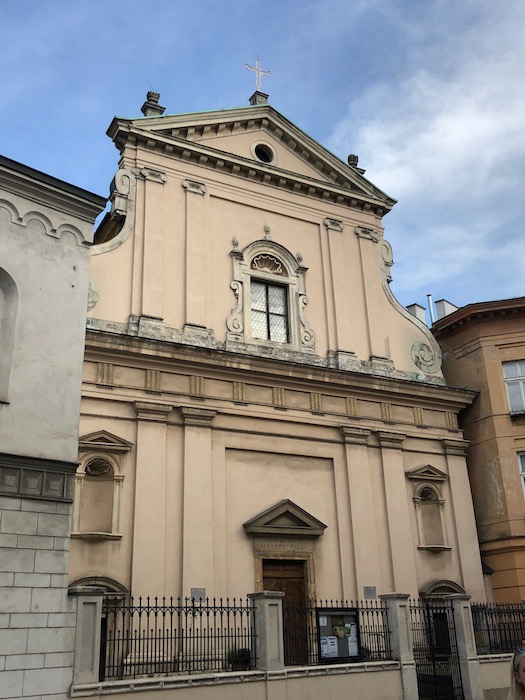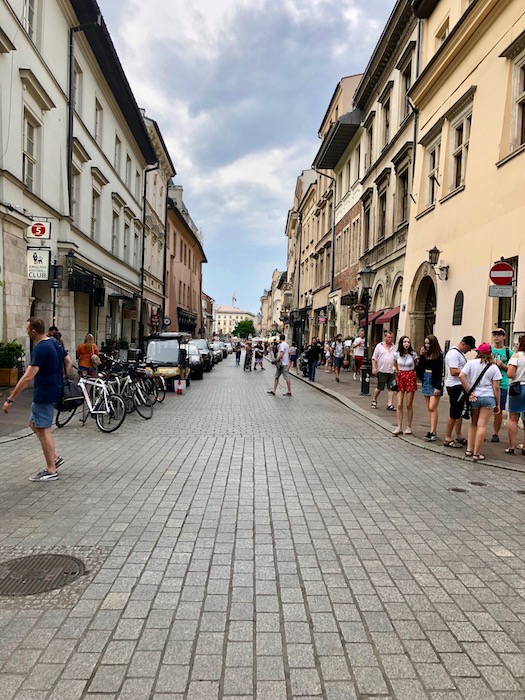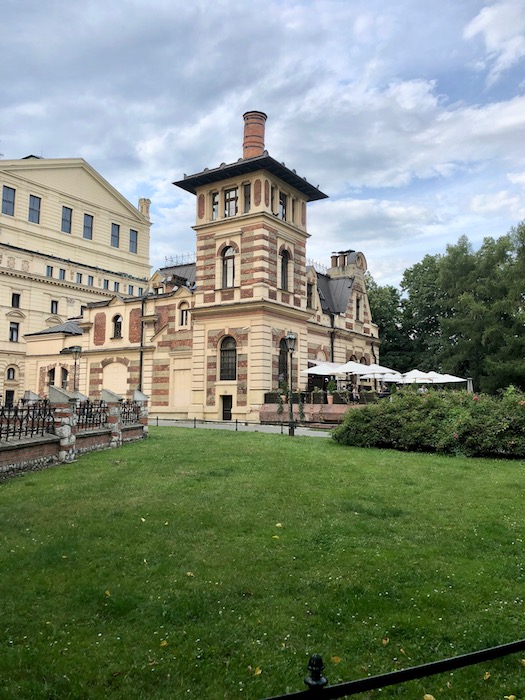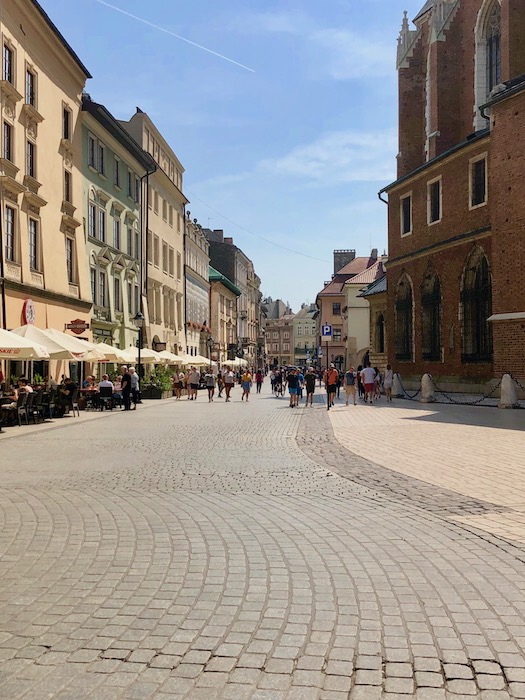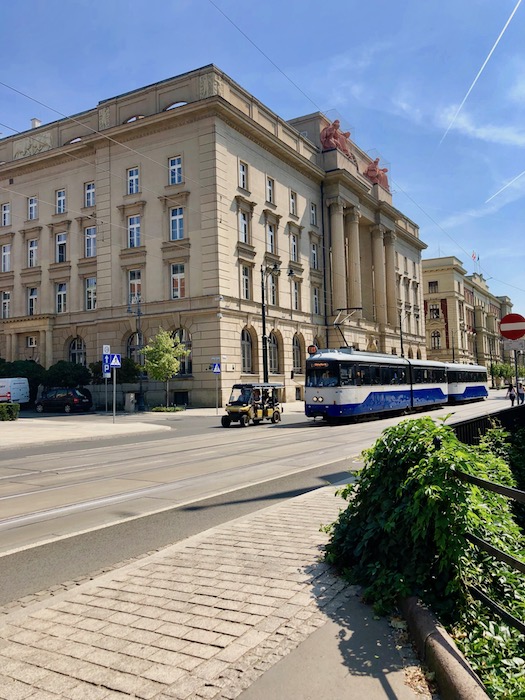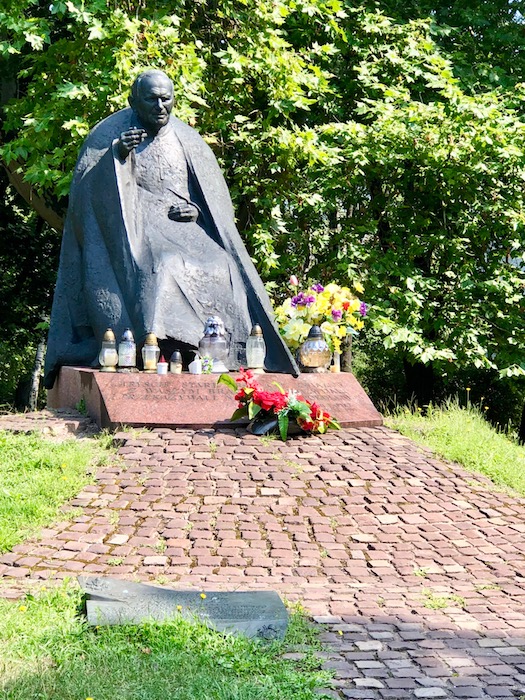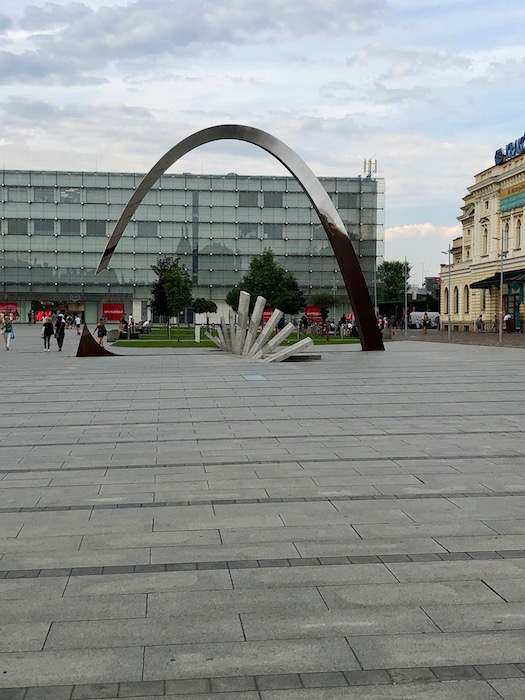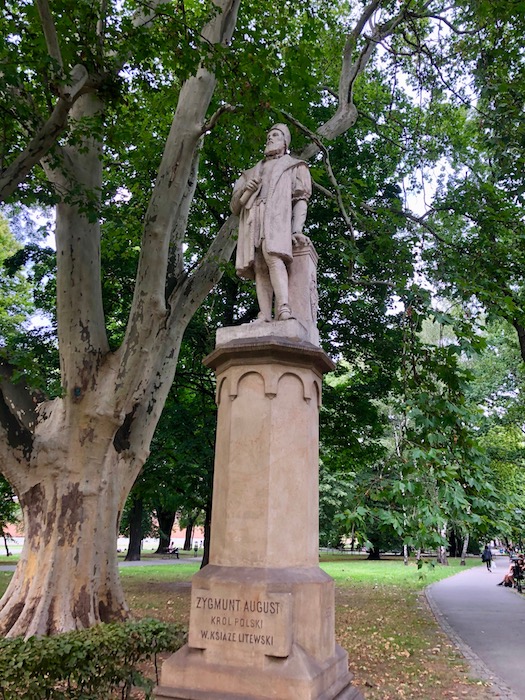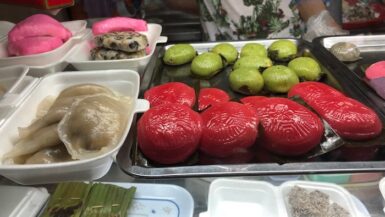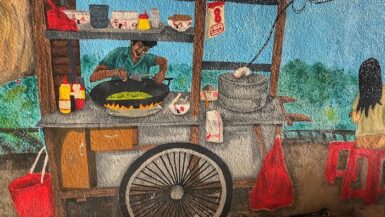August 6, 2019
Since I hadn’t yet been to the city center, I really wasn’t sure where I was supposed to meet the guide for the food tour. The directions were to meet at the Barbican near St. Florian’s Gate. The Barbican turns out to a large round brick building that looks like the citadels in Lviv, and St. Florian’s Gate is one of the remaining gates built into the wall surrounding the city.
I was sitting on a bench contemplating whether I should move closer to the Barbican when I saw an orange umbrella open – the sign that the guide for Secret Food Tours had arrived.
Mateusz (“just call me Matt”) kindly told me that it would be just the two of us – how lucky am I – another private tour. He then handed me an obwarzanek, a ring of dough sprinkled with salt. Much like a bagel, an obwarzanek is boiled and then baked, but it is much bigger and thinner than a bagel. Matt told me that it is traditional to welcome someone into a Polish home with bread and salt. It is a symbol of hospitality. Of course, if you are going easy on the salt, obwarzaneks can be topped with sesame or poppy seeds. They are also an all-day, any time snack – there are carts everywhere selling them.
After trying a bite of the bread, we were off through the streets of the old town, passing interesting architecture, shops, and a brightly colored tiny church that I made a mental note to come back to later.
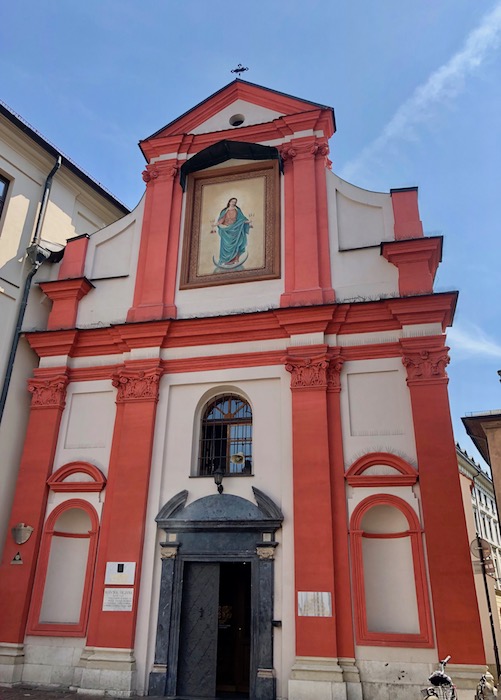
We arrived at our first stop, a local pub by the name of BaniaLuka Zbliza. It was a little before noon, but there was a group of guys already enjoying a round of beers when we walked in.
Although I don’t drink much, I agreed to try a few sips of Tyskie, a local brew. It was a nice, light golden ale and it was supposed to pair nicely with the first dish of the day – Hunter’s Stew. If you don’t like sauerkraut, you won’t like this stew. The ingredients are: (1) sauerkraut (I think the sourer the better); (2) meat – any kind of meat will do, but usually beef and sausages; and (3) spices – allspice, salt, pepper and bay leaves – don’t eat the bay leaves. When it’s all mushy and the flavors have blended, it’s ready to eat. Like anything else filled with spice, it’s probably much better the second or third day after it’s had time to sit.
Now I’m not a really big fan of sauerkraut, but I did like the stew. I must admit that I ate all of the pieces of meat out of the bowl and left a healthy portion of the cabbage mixture untouched, but I liked it overall. I think it might have even been better with a little dollop of sour cream on top (or maybe that’s because I’ve been influenced by Ukrainian cooking). Matt was right, the beer went well with the soup.
As Matt and I got to know each other, we talked primarily about food. I asked, and he told me that Poles eat their big meal at dinner, about 5 or 6 pm. They always have two courses – a bowl of soup and then meat, potatoes, and salad. Poles are big “soup people,” particularly in the cold winters. We talked about the differences between borsch from Ukraine and Poland. Polish borsch is a clear soup with pieces of beet in it. Apparently, poles like clear soups over cream soups, except in the case of Zurek, a white sour borsch. Nothing like bonding over soup talk.
I finished neither my stew nor my beer, but we left for our next stop, a restaurant serving traditional highland Polish food. Matt asked that we be seated downstairs, which is very rustic and full of character (I find that the best places are in basements or cellars). We were here to try two appetizers and a glass of wine.
Matt didn’t twist my arm about trying the wine, but he made a convincing case that it paired very well with both dishes. When you think about wine, you don’t think Poland, but the few sips I had of the rose wine from Turnau vineyard showed that it was dry with fruity notes. Appetizers were fried oscypek or highlander’s cheese (kind of like squeaky cheese) with a cranberry compote, and moskole – baked potato pancakes served with garlic butter. The photo only shows one pancake because I’d already dived in and forgot to take a picture pre-devouring. The cheese was very good – what’s not to love about fried cheese, but it was very heavy. The potato pancakes were a little dry due to being baked and not fried, but the garlic butter made up for it.
By this time, Matt and I had become fast friends. Our conversation branched out into traveling, life, and politics. We could probably have sat there chatting away, but we needed to push onward to more food locales.
Our next stop was at Matt’s preferred pierogi place. It was a little hole in the wall with about ten tables and lots of ambience. Unfortunately, it didn’t have any air conditioning, so it was a little hot and humid in the restaurant. All but one table was taken – ours had a reserved sign.
From the dozen or so types of pierogis, Matt selected one and told me I had to guess which one it was from the descriptions. I failed miserably. The pierogi he chose for me was stuffed with mushrooms, cheese, and egg and topped with a little onion for good measure. Although similar to other dumplings I’ve had, the dough used for the pierogis seamed to be fluffier and lighter than say, varenyky or khinkali. They were delicious. I didn’t finish the plate he put in front of me because I was beginning to get full and I knew we had a few more stops to make. Since there was a line out the door of people waiting for tables, we moved on.
Matt had already told me that we would be trying a herring snack, which I was not overjoyed about; however, the little out of the way restaurant down an alley was cute. Here, I was going to try pink herring – basically a mixture of cooked herring and beets. Paired with the herring, we would be trying Zubrowka, a special vodka flavored with bison grass.
After a toast, I took a sip of the vodka – wow, what a burn. My eyes watering, I took my first taste of the pink herring. I didn’t hate it, but I didn’t love it. When I put a little on top of the soft rye bread that came alongside of the fish, it was a little better; but only a little. Zubrowka is served room temperature, but when I put some ice in my shot glass to chill it, the vodka became palatable.
By this time, Matt and I had become pals. We talked about family, friends, more politics, and even religion. He even gave me an antidote for stomach issues (I told him about my earlier illness and he agreed the bottled water I drank had a higher content of minerals than I was probably used to) – one to two shots of vodka mixed with black pepper. I think I’ll stick with Tums.
For our last stop, we walked up the hill to Wawel Castle and through the courtyard in front of the cathedral to an outdoor café.
Matt presented me with a huge piece of papal cake – Pope John Paul II’s favorite cake. More like a Napoleon than a traditional cake, the filling is like thick, gooey vanilla pudding. The powdered sugar is festive, but when you cut into the cake, it goes flying and gets on everything. But it was so, so good. No wonder it was the Pope’s favorite.
We sat chatting and then I looked at my watch – four hours had passed and it was time for Matt to leave. Mateusz was a wonderful guide and conversationalist. I had lots of fun learning about traditional Polish food and so many other topics. He made me feel at ease even though we were only a tour group of two. Secret Food Tours Krakow and Mateusz were definitely fun food finds.
After Matt left, I finished my papal cake and headed back in the general direction of the apartment. I did not take a direct route though as it took about three hours to get back. I wandered up this road and down that road, seeing where they took me.
Besides people watching, wandering is my favorite thing to do to get to know a city. What I learned of Krakow is that it has a charm about it. Interesting places lurk around every corner. I think I will need more time to even scratch the surface.

